William Moore
Hybrid Learning: A Novel Combination of Self-Supervised and Supervised Learning for MRI Reconstruction without High-Quality Training Reference
May 09, 2025Abstract:Purpose: Deep learning has demonstrated strong potential for MRI reconstruction, but conventional supervised learning methods require high-quality reference images, which are often unavailable in practice. Self-supervised learning offers an alternative, yet its performance degrades at high acceleration rates. To overcome these limitations, we propose hybrid learning, a novel two-stage training framework that combines self-supervised and supervised learning for robust image reconstruction. Methods: Hybrid learning is implemented in two sequential stages. In the first stage, self-supervised learning is employed to generate improved images from noisy or undersampled reference data. These enhanced images then serve as pseudo-ground truths for the second stage, which uses supervised learning to refine reconstruction performance and support higher acceleration rates. We evaluated hybrid learning in two representative applications: (1) accelerated 0.55T spiral-UTE lung MRI using noisy reference data, and (2) 3D T1 mapping of the brain without access to fully sampled ground truth. Results: For spiral-UTE lung MRI, hybrid learning consistently improved image quality over both self-supervised and conventional supervised methods across different acceleration rates, as measured by SSIM and NMSE. For 3D T1 mapping, hybrid learning achieved superior T1 quantification accuracy across a wide dynamic range, outperforming self-supervised learning in all tested conditions. Conclusions: Hybrid learning provides a practical and effective solution for training deep MRI reconstruction networks when only low-quality or incomplete reference data are available. It enables improved image quality and accurate quantitative mapping across different applications and field strengths, representing a promising technique toward broader clinical deployment of deep learning-based MRI.
COVID-19 Prognosis via Self-Supervised Representation Learning and Multi-Image Prediction
Jan 25, 2021
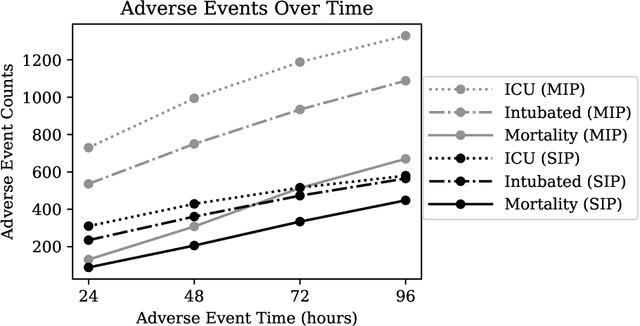
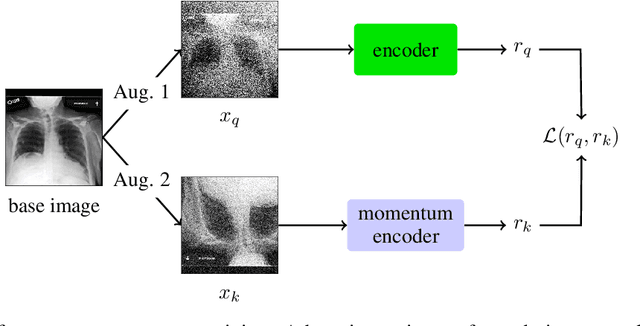
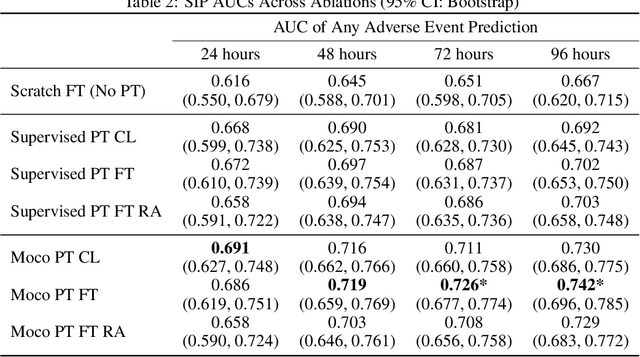
Abstract:The rapid spread of COVID-19 cases in recent months has strained hospital resources, making rapid and accurate triage of patients presenting to emergency departments a necessity. Machine learning techniques using clinical data such as chest X-rays have been used to predict which patients are most at risk of deterioration. We consider the task of predicting two types of patient deterioration based on chest X-rays: adverse event deterioration (i.e., transfer to the intensive care unit, intubation, or mortality) and increased oxygen requirements beyond 6 L per day. Due to the relative scarcity of COVID-19 patient data, existing solutions leverage supervised pretraining on related non-COVID images, but this is limited by the differences between the pretraining data and the target COVID-19 patient data. In this paper, we use self-supervised learning based on the momentum contrast (MoCo) method in the pretraining phase to learn more general image representations to use for downstream tasks. We present three results. The first is deterioration prediction from a single image, where our model achieves an area under receiver operating characteristic curve (AUC) of 0.742 for predicting an adverse event within 96 hours (compared to 0.703 with supervised pretraining) and an AUC of 0.765 for predicting oxygen requirements greater than 6 L a day at 24 hours (compared to 0.749 with supervised pretraining). We then propose a new transformer-based architecture that can process sequences of multiple images for prediction and show that this model can achieve an improved AUC of 0.786 for predicting an adverse event at 96 hours and an AUC of 0.848 for predicting mortalities at 96 hours. A small pilot clinical study suggested that the prediction accuracy of our model is comparable to that of experienced radiologists analyzing the same information.
An artificial intelligence system for predicting the deterioration of COVID-19 patients in the emergency department
Aug 04, 2020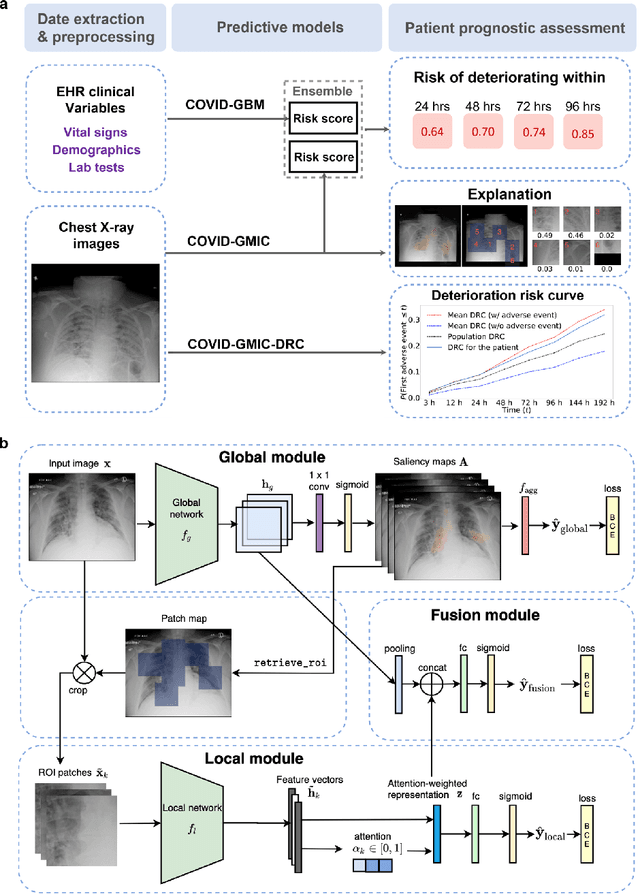
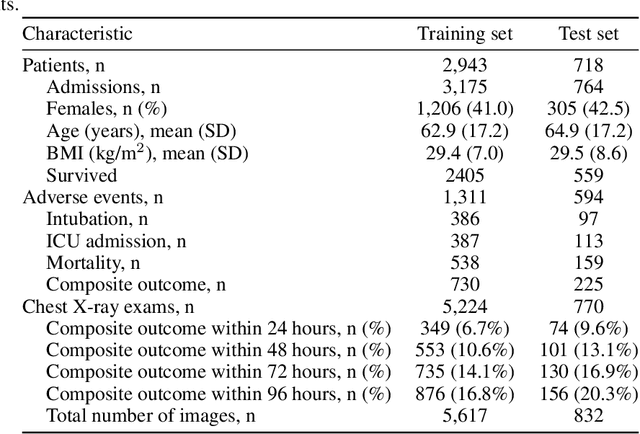
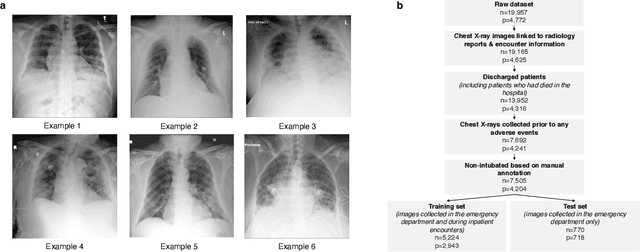
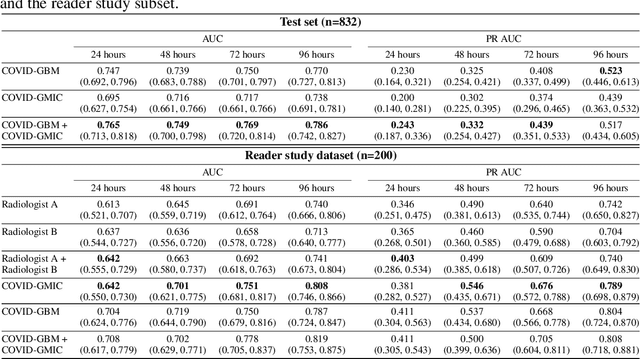
Abstract:During the COVID-19 pandemic, rapid and accurate triage of patients at the emergency department is critical to inform decision-making. We propose a data-driven approach for automatic prediction of deterioration risk using a deep neural network that learns from chest X-ray images, and a gradient boosting model that learns from routine clinical variables. Our AI prognosis system, trained using data from 3,661 patients, achieves an AUC of 0.786 (95% CI: 0.742-0.827) when predicting deterioration within 96 hours. The deep neural network extracts informative areas of chest X-ray images to assist clinicians in interpreting the predictions, and performs comparably to two radiologists in a reader study. In order to verify performance in a real clinical setting, we silently deployed a preliminary version of the deep neural network at NYU Langone Health during the first wave of the pandemic, which produced accurate predictions in real-time. In summary, our findings demonstrate the potential of the proposed system for assisting front-line physicians in the triage of COVID-19 patients.
 Add to Chrome
Add to Chrome Add to Firefox
Add to Firefox Add to Edge
Add to Edge